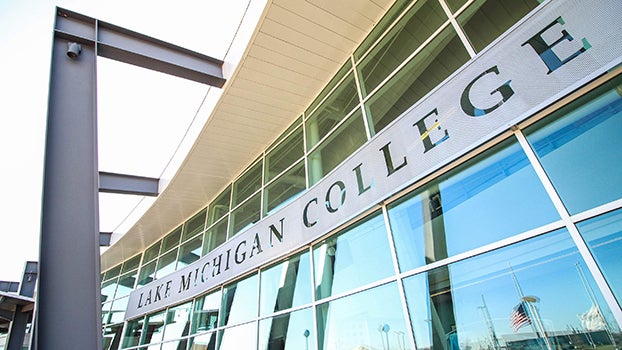Author details manhunt for St. Valentine’s Day Massacre shooter
Published 10:44 am Friday, November 3, 2017

- (Leader photo/TED YOAKUM)
DOWAGIAC — While the infamous 1929 gang shooting may have occurred on the North Side of The Windy City, it was through the investigative efforts of law enforcement officials in southwest Michigan that brought one of the men responsible for the bloody St. Valentine’s Day Massacre to justice.
Michigan author Chriss Lyon detailed the historic two-year manhunt for prohibition-era hitman Fred “Killer” Burke during her presentation at the Dowagiac Area History Museum Wednesday, titled “Fred Burke: The Most Wanted Man in America in 1929.” The talk was the latest in the museum’s fall lecture series, and drew yet another packed house to the basement of the downtown building.
Lyon, a public safety professional and historian, is the author of 2014’s “A Killing in Capone’s Playground: The True Story of the Hunt for the Most Dangerous Man Alive.” The true crime book recounts the search for Burke, one of the main suspects in the 1929 Chicago shooting that left seven, who was eventually caught after police in Berrien County discovered two Thomson submachine guns belonging to the Al Capone-linked killer in a home in St. Joseph.
Burke was born Thomas A. Camp in Mapleton, Kansas, in 1893. Although he grew in a small, humble community, Camp was drawn to a life of crime as a teenager, after a conman visited his home trying to sell his family forged property deeds.
Moving to Missouri — which at the time was a “wet state,” where people could buy alcohol, in comparison to “dry states” like Kansas that did not allow alcohol — Camp become involved with the Egan’s Rats gang in St. Louis. In 1917, he was arrested for the first time for fraud and forgery, while a year later, he was arrested again for “suspicious character,” Lyon said.
“That was a pretty much a catch all for ‘we don’t know what to arrest you for, but you’re suspicious so we’re just going to get you,’” Lyon said.
After his second release from jail, Camp enlisted in the U.S. Army in order to fight overseas in World War I. Serving as a tank sergeant the 329th Battalion, Camp fought in France until he was discharged from service in May 1919.
Unfortunately, Camp’s stint in the military did little to curb his predilection toward crime, and instead gave him the skills that would make him a more effective killer later in life.
“Uncle Sam taught him how to shoot a machine gun,” Lyon said. “Turned out that he was pretty good at it.”
After returning to the U.S., Camp moved to Detroit, where he was arrested for taking money under false circumstances. After a year-long stint in prison, he moved back to St. Louis, where he assumed the alias of Fred Burke.
His crimes soon escalated from petty forgery and cons to armed robberies and kidnapping schemes across the Midwest. Burke’s criminal behavior — and skills with a Tommy Gun — caught the attention of Chicago crime lord Al Capone, who hired him to assassinate one of his former friends, Frankie Yale, in New York City in 1928.
A year later, on Feb. 14, Burke and several of his associates, some dressed as police officers, lured seven people associated with Capone’s rival, Bugs Moran, into a garage on Clark Street in Chicago. After they were inside, the gangsters opened fire on the other men, with several of the victims shot numerous times with a Thomson machine gun.
“There was no rhyme or reason why they got shot that many times, but a few of them took more than few bullets to go down,” Lyon said.
In spite of the killing, later dubbed the St. Valentine’s Day Massacre, drawing international outrage, police made little headway in their investigation. Every one of Capone’s men they arrested for the crime were released due to alibis or lack of evidence, while forensics, still in its infancy in 1929, were able to unearth any clues.
Burke, meanwhile, later began living in St. Joseph under the name Frederick Dane.
On the night of Dec. 14, 1929, a patrolman with the St. Joseph Police Department named Charles Skelly came upon a drunken Burke after the man’s vehicle rear ended another. When Skelly approached Burke’s car, the criminal shot the officer three times and drove off, leaving the man to die.
Skelly was later found and taken to the hospital for treatment, though it was too late to save his life. Before his death, his fellow officers asked him who had shot him, to which Skelly replied “the man on the lake shore.”
A massive manhunt ensued, with Berrien County Sheriff’s Department joined by other local police forces and the Michigan State Police Department to locate Skelly’s killer.
“They were taking this personally,” Lyon said. “[Skelly] was 25 years old, and was in the prime of his life.”
Police found Burke’s wrecked and abandoned vehicle a short time later, and traced it to a bungalow owned by the man, who police learned was a suspect in the St. Valentine’s Day Massacre. When police searched the residence, only Burke’s girlfriend was found — though they discovered a host of weaponry, including two Tommy guns that police later traced to both the Chicago shooting as well as Yale’s assassination the year before.
Unfortunately, Burke had skipped town yet again, and any leads all disappeared.
A year later, though, a man living in Green City, Missouri, after reading about the massacre in a true crime magazine, saw someone who resembled Burke living in the city. Police later confirmed that the man, now living as Richard White, was indeed the gangster, and was taken into custody.
As St. Joseph authorities had the strongest case against the man, Burke was tried in Michigan, where he was convicted of second-degree murder for the killing of Officer Skelly in 1931. Burke was given a life sentence and was transported to Marquette to serve out his term.
Oddly, the violent killer seemed at peace with his fate, even happily posing for photos with police during his journey to the penitentiary. Lyon said that Burke saw prison as a sort of retirement, where, behind the walls of the prison, rival gang members could not touch him.
“He never talked about anything while he was out there,” Lyon said. “Every time police would come up to him and try to pick his brain, he would slam the cell door shut on them.”
Nine years later, Burke died of a heart attack. He is buried under the name Theodore Camp in a cemetery in Marquette.
While her presentation may have focused on the life of Burke, Lyon closed her presentation with a tribute to Officer Skelly, whose tragic demise helped crack one of the country’s most infamous cases.
“He never knew what he did,” Lyon said. “He never knew the impact that he made on forensics, on science, on society and on this case.”






